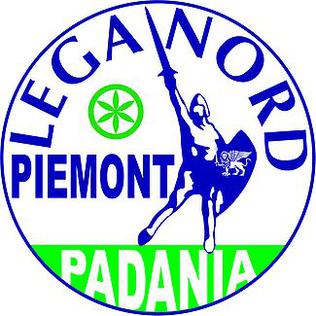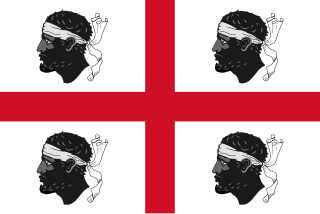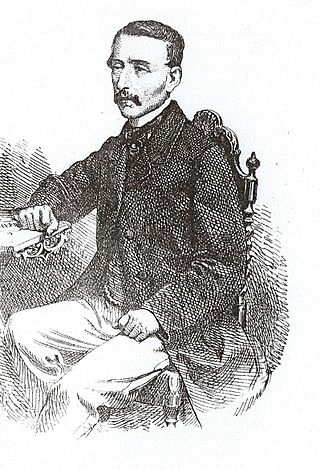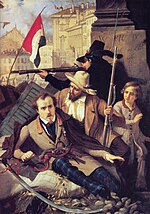
The Papal States, officially the State of the Church, were a series of territories in the Italian Peninsula under the direct sovereign rule of the pope from 756 until 1870. They were among the major states of Italy from the 8th century until the unification of Italy, between 1859 and 1870.

The unification of Italy, also known as the Risorgimento, was the 19th-century political and social movement that resulted in the consolidation of different states of the Italian Peninsula and its outlying isles into a single state in 1861, the Kingdom of Italy. Inspired by the rebellions in the 1820s and 1830s against the outcome of the Congress of Vienna, the unification process was precipitated by the Revolutions of 1848, and reached completion in 1871 after the capture of Rome and its designation as the capital of the Kingdom of Italy.

Cesare Balbo, Conte di Vinadio, was an Italian writer and statesman.
Il Risorgimento was a liberal, nationalist newspaper founded in Turin 15 December 1847 by Camillo Benso, Count of Cavour and Cesare Balbo, who was a backbone of the "neo-Guelph" party that saw in future a rejuvenated Italy under a republican government with a papal presidency—ideas with which Cavour did not agree. The two men were soon joined by Pietro di Santa Rosa and Michelangelo Castelli, who soon assumed the position of vice-director. Publication began as a result of the relaxation of stringent press control which made the newspaper financially viable. Within weeks the paper, conceived as a weekly, was published daily, as revolutionary events, initiated by an insurgency in Palermo and demonstrations in Genoa, gained momentum. The paper was initiated to form a moderate middle-class "respectable" balance to the more radical "democratic" program of Concordia, which was initiated at the same time. The initial editorial by Cavour made the following claim: "Our aim not being of making money but of enlightening the country and of cooperating with the grand works of "Resurgence" initiated by the government".

The Guelphs and Ghibellines were factions supporting respectively the Pope and the Holy Roman Emperor in the Italian city-states of Central Italy and Northern Italy during medieval time.

Luigi Carlo Farini was an Italian physician, statesman and historian.

Massimo Taparelli, Marquess of Azeglio, commonly called Massimo d'Azeglio, was a Piedmontese-Italian statesman, novelist and painter. He was Prime Minister of Sardinia for almost three years, until his rival Camillo Benso, Count of Cavour succeeded him. D'Azeglio was a moderate liberal who hoped for a federal union between Italian states.

Vincenzo Gioberti was an Italian Catholic priest, philosopher, publicist and politician who served as the Prime Minister of Sardinia from 1848 to 1849. He was a prominent spokesman for liberal Catholicism.

The history of Italy from 1559 to 1814 was characterized by the domination of foreign nations over Italy, and corresponds to the period that began in 1559 with the end of the Italian Wars and ended in 1814 with the fall of Napoleon. The following period was characterized by political and social unrest which then led to the unification of Italy, which culminated in 1861 with the proclamation of the Kingdom of Italy.

Renzo Rabellino is the leader of the No Euro Movement, a political party in Italy that advocates the return of the Italian lira for the Italian currency and government control of the central bank.

Giuseppe Spataro was an Italian politician.

Lega Piemonte, whose complete name is Lega Piemonte per Salvini Premier, is a regionalist political party active in Piedmont. Established in 1987, it was one of the founding "national" sections of Lega Nord (LN) in 1991 and has been the regional section of Lega per Salvini Premier (LSP) in Piedmont since 2020.

The Kingdom of Sardinia, also referred to as the Kingdom ofSardinia-Piedmont or Piedmont-Sardinia as a composite state during the Savoyard period, was a country in Southern Europe from the late 13th until the mid 19th century.

Carlo Ilarione Petitti count of Roreto was an Italian economist, academic, writer, counsellor of state, and senator of the Kingdom of Sardinia. He is seen as a prominent figure in the Italian Risorgimento.

The Papal Navy was the maritime force of the Papal States. Loosely construed, it was in sporadic existence from approximately the Battle of Ostia (849) during the pontificate of Leo IV until the ascension of Pope Leo XIII in 1878.
The Moderate Party, collectively called Moderates, was an Italian pre-Unification political rally, active during the Risorgimento (1815–1861). The Moderates were never a formal party, but only a movement of liberal-minded reformist patriots, usually secular, from politics, military, literature and philosophy.

Carlo Vincenzo Ferrero d'Ormea was an Italian politician and diplomat. He was president of the Council of the Kingdom of Sardinia from 1742 to 1745.

The cockade of Italy is the national ornament of Italy, obtained by folding a green, white and red ribbon into a plissé using the technique called plissage (pleating). It is one of the national symbols of Italy and is composed of the three colours of the Italian flag with the green in the centre, the white immediately outside and the red on the edge. The cockade, a revolutionary symbol, was the protagonist of the uprisings that characterized the Italian unification, being pinned on the jacket or on the hats in its tricolour form by many of the patriots of this period of Italian history. During which, the Italian Peninsula achieved its own national unity, culminating on 17 March 1861 with the proclamation of the Kingdom of Italy. On 14 June 1848, it replaced the azure cockade on the uniforms of some departments of the Royal Sardinian Army, while on 1 January 1948, with the birth of the Italian Republic, it took its place as a national ornament.

Count Emanuele Balbo Bertone di Sambuy, Marquess of Breme was an Italian general during World War II.

The People's Union is a left-wing political alliance in Italy launched on 9 July 2022 by Luigi de Magistris.


















